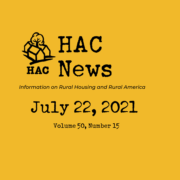HAC News: September 2, 2021
Vol. 50, No. 18
TOP STORIES
Supreme Court invalidates eviction moratorium.
The Centers for Disease Control did not have sufficient authority to issue its August 3 eviction moratorium, the Supreme Court ruled on August 26. The court held that the administration cannot impose another moratorium on tenant evictions unless Congress specifically authorizes it. HAC expressed concern about the decision’s impact on rural residents, given that the pandemic and the unprecedented job loss it caused have exacerbated longstanding rural housing challenges. Some state and local eviction limitations remain in place. Resources for tenants, landlords, and homeowners are collected on HAC’s site.
Agencies take steps to assist renters.
Federal agencies have instituted new flexibilities and issued reminders to help tenants who have fallen behind on rent and utilities payments.
- USDA will work with its multifamily property owners to mitigate evictions. USDA also announced permission for owners to access reserves for operating shortfalls while waiting to receive Emergency Rental Assistance, financial incentives to property management agents that tap ERA to clear arrearages, and increased support from USDA field staff.
- The Treasury Department issued revised FAQs and an announcement about policy changes intended to help state and local governments and their partners to distribute Emergency Rental Assistance funds.
- “Shallow Subsidy” rental assistance funds for veteran households are now available nationwide from VA’s Supportive Services for Veteran Families program.
- HUD Secretary Marcia Fudge, Treasury Secretary Janet Yellen, and Attorney General Merrick Garland encouraged states and localities to act, including imposing eviction moratoriums and connecting eviction proceedings to rent aid applications.
Administration efforts to provide more affordable housing announced.
On September 1, the Biden administration announced a series of actions it intends to take to increase the supply of affordable homes for renters and owners. The provisions include raising the caps on Fannie Mae’s and Freddie Mac’s Low Income Housing Tax Credit investments and requiring a larger portion of those LIHTC investments be targeted to rural places; increasing financing for CDFIs; emphasizing sale of foreclosed single-family homes to families and nonprofits; and increasing state housing finance agencies’ ability to finance affordable rental housing by restarting the Federal Financing Bank’s support of FHA’s Risk-Sharing Program. The administration also asked state and local governments to remove regulatory barriers.
Budget resolution and infrastructure bill move in House.
The House passed the $3.5 trillion budget resolution on August 24. Next, committees in both the House and the Senate will draft legislative language, including specific amounts for specific programs. The House also moved forward on the bipartisan infrastructure bill, scheduling a vote for September 27. Annual appropriations bills for FY22, which begins on October 1, 2021, have not advanced; Congress will need to adopt a continuing resolution to keep the government functioning beyond September.
Save the date! 2021 National Rural Housing Conference scheduled.
HAC is pleased to announce plans to convene its 2021 National Rural Housing Conference and Training! The conference provides an excellent opportunity to network and improve connections to federal agencies, national intermediary organizations, and other stakeholders. The HAC News will announce when registration opens.
Nominate individuals or organizations for rural housing awards.
As part of the 2021 National Rural Housing Conference, HAC will recognize individuals and/or organizations that have, through their continued work and or newly established initiatives, made a positive and lasting impact in rural America. HAC invites nominations by September 17 of those who have made outstanding and enduring contribution to affordable housing in rural America. This year, HAC will consider each nomination on its own merits, relative to the specified contributions. More details and a list of potential categories are posted on HAC’s site. For more information, contact Miguel Guevara, HAC.
RuralSTAT
Between August 1 and August 31, communities outside of metropolitan areas reported nearly 700,000 new cases of COVID-19 – a 291% increase over the previous 30-day period. Source: HAC tabulations of public health data from the New York Times. A Rural Research Note updating the COVID-19 situation in rural America is available on HAC’s site.
OPPORTUNITIES
HUD offers funds for Native American housing.
- The Indian Housing Block Grant competitive program helps tribes and Tribally Designated Housing Entities maintain, develop, and operate affordable housing. The deadline is December 1. For more information, contact HUD staff.
- The Indian Community Development Block Grant program will finance tribes to develop community facilities, carry out public works projects, and provide economic development assistance. Apply by October 25. For more information, contact HUD staff.
- HUD will accept applications for ICDBG funds appropriated by the American Rescue Plan Act in accordance with HUD Notice PIH-2021-22. For more information, contact HUD staff.
Webinar planned on rural community engagement.
CIRD: Models and Practices for Meaningful Community Engagement, scheduled for September 15, will ask what meaningful community engagement work looks like for rural communities. The webinar, sponsored by the Citizens’ Institute for Rural Design, will give participants a chance to share engagement strategies and learn new ways to strengthen community engaged design work. It will also cover engagement in the context of COVID-19 and building greater inclusivity with community members whose identities differ from our own.
HAC seeks Community Facilities Housing Specialist.
The Community Facilities Housing Specialist identifies and engages community stakeholders and provides direct technical assistance to rural organizations that are developing facilities such as parks, community centers, public libraries and childcare centers. This includes helping them identify, utilize, and apply for financial resources such as USDA Community Facilities grants and loans. This is a two-year position and is eligible for telecommuting.
REGULATIONS AND FEDERAL AGENCIES
“Public charge” comments sought.
U.S. Citizenship and Immigration Services is revising the regulation that bars immigrants considered likely to become “public charges” because of their use of government assistance. Comments are due October 22. USCIS will hold virtual listening sessions on September 14 (for the general public) and October 5 (for state, local, and tribal governments and nonprofits). For more information, contact Andrew Parker, USCIS, 240-721-3000.
Reimbursement for non-congregate shelters extended.
FEMA will provide 100% reimbursement for some emergency measures taken through December 31, 2021 by state, local, and tribal governments and nonprofits to protect against immediate threats to life, public health, or property. During the coronavirus disaster, this category includes non-congregate sheltering of people experiencing homelessness.
Input requested on federal homelessness plan.
The U.S. Interagency Council on Homelessness seeks public comments as it creates a new Federal Strategic Plan to Prevent and End Homelessness. USICH invites feedback from anyone, particularly people who have experienced or are currently experiencing homelessness; people who serve the LGBT, BIPOC, or veteran communities; and people whose work involves the justice system.
HAC agrees with HUD fair housing rule.
HAC has submitted a comment letter supporting HUD’s proposed cancellation of a fair housing regulation issued by the Trump administration in September 2020. This rule governs fair housing violation claims based on policies or actions with “disparate impacts” on categories of people protected by the Fair Housing Act.
PUBLICATIONS AND MEDIA
HAC offers information for survivors of Hurricane Ida and TN floods.
Disaster guides for areas hit by Hurricane Ida and for places in middle Tennessee that flooded on August 21 are posted on HAC’s website.
CDBG-CV Rural Economic Development Quick Guide published.
A new guide from HUD is intended to help states and rural places use Community Development Block Grant CARES Act (CDBG-CV) funding to support the local economic development infrastructure needed for pandemic recovery. The guide covers the economic development needs of rural communities, best practices, and duplication of benefits.
Housing helps Navajo Nation deal with pandemic.
For Navajo, Crowded Homes Have Always Been a Lifeline. The Pandemic Threatens That, an interactive video published by the Washington Post, illustrates both pre-pandemic housing inadequacies on the Navajo Nation and the cultural importance of multi-generational living. About 300 tiny homes have been built near existing residences to allow family members to isolate as necessary.
As federal pandemic relief ends, rural food insecurity is expected to rise.
The Daily Yonder reports in Experts: Food Insecurity in Rural Areas Likely to Increase in Months to Come that as federal benefits such as unemployment assistance expire in September, food insecurity will probably increase. Previous studies have indicated that rural areas have higher rates of food insecurity than the rest of the country.
Rural news providers try to bridge the information divide.
Nieman Reports provides an overview of six rural-based news outlets, including the Daily Yonder, Southerly, the News Reporter, High Country News, Ohio Valley ReSource, and Mountain State Spotlight. These outlets aim to provide culturally competent news that is important to local audiences.
Need capital for your affordable housing project?
HAC’s loan fund provides low interest rate loans to support single- and multifamily affordable housing projects for low-income rural residents throughout the U.S. and territories. Capital is available for all types of affordable and mixed-income housing projects, including preservation, new development, farmworker, senior and veteran housing. HAC loan funds can be used for pre-development, site acquisition, site development, construction/rehabilitation and permanent financing. Contact HAC’s loan fund staff at hacloanfund@ruralhome.org, 202-842-8600.
Please note: HAC is not able to offer loans to individuals or families. Borrowers must be nonprofit or for-profit organizations or government entities (including tribes).

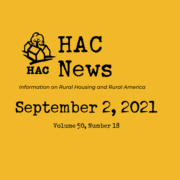

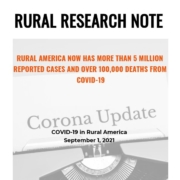
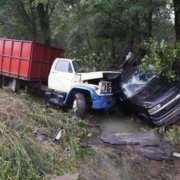
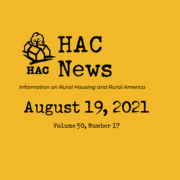
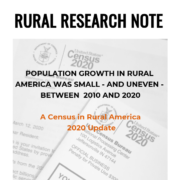 Housing Assistance Council
Housing Assistance Council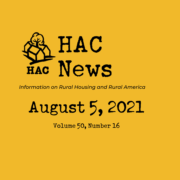
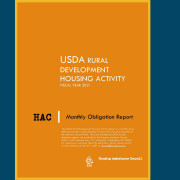
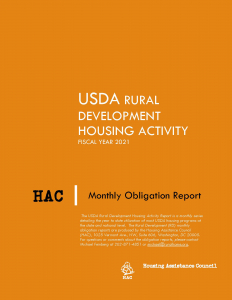
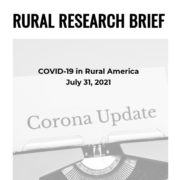 Housing Assistance Council
Housing Assistance Council